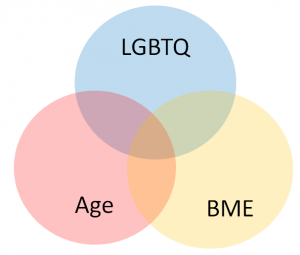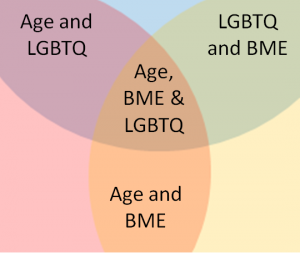Last month I spoke at GENOVATE’s international conference on diversity within research and universities. I am not thrilled about the term “diversity” and find a lot of the discourse around it really problematic, but I do think it’s important to talk about the phenomenon it describes. It’s what happens when reading lists are full of dead white men and the images on the slides never show people like you. It’s what happens when you’re never taught by someone who looks a little like you, when your mentors don’t experience the things that you do and cannot advise you on dealing with it, when you look at the entity that is the university and cannot see yourself reflected back. From my own experiences and from what others have discussed with me, there’s a lurch as you realise that you’re less welcome in this space that you thought you were, or that your fears are confirmed and that this place isn’t meant for people like you.
I drew on Nathaniel Adam Tobias C—‘s “Diversity is a dirty word” to trouble and reject easy ideas about diversity. C— argues that there are four key strands to challenge in diversity: the “what”, the “how”, the “who” and the “where”.
- The “what” is the Syllabus: the choice of topics, resources, examples or case studies
- The “how” is the Process: the teaching methods and learning activities
- The “who” are the Participants: the students, the tutors, and the epistemic authorities on the programme
- The “where” is the Environment: the rooms and buildings, the signs and statues, and the local area, taking into consideration the accessibility of these spaces, both physically and socially
After my talk, someone asked me a question focusing on the “who”: what if you’re teaching, but your students don’t seem to be “diverse” (meaning, I would argue, that they do not appear to deviate from the straight, white, cis, able-bodied student that we might imagine. The word “appear” is important). I said then that I would teach as if such diverse students were in the room: after all, we cannot assume that they’re not. Here is why.
Students are not obliged to out themselves
Not all identities or experiences are immediately visible. I might be able to guess at some of my students’ LGBTQ, disabled, ethnic or religious identities if my students make them visible. Sometimes, these things are made visible to me by and through university systems; namely, information about disability that affects how a student learns and is assessed. Sometimes, my students have revealed things to me: their mental health issues, a physical disability that is not apparent to an onlooker, their gender identity, their sexual assault. I have then tried to be extra careful about how I talk about these things, extra aware of how the class discussion moves and where it goes.
However, I have certainly taught students who didn’t feel the need to tell me. Given that the NUS has identified that 37% of female students have experienced unwanted sexual advances and the gender makeup of the courses I teach, I am confident that I’m teaching a few women who have had such experiences. They shouldn’t have to explicitly tell me so. Their presence in the room, and my sensitivity to these unspoken experiences should not be contingent in knowing that such students are here.
It sounds obvious, but students should never have to out themselves to be taught in a non-hurtful way. I have heard enough horror stories about lecturers making crass jokes about mental health, disability, sexual assault, gender and sexuality that have had to be confronted by a student saying “look, I’m ____ and that’s really inappropriate” – an especially fraught interaction. I’ve had to challenge a colleague who would always joke before IELTS tests: “fill in the box for male or female – it’s the easiest question you’ll face today!”; for some people (including me), that’s not an easy question.
However, the onus shouldn’t be on students to reveal something that they may consider personal and private in order to challenge us. The onus should be on us to make sure that we aren’t excluding some of our students.
Students are not isolated
Students have families, friends, colleagues, communities. I cannot know whether one of my students’ parents uses a wheelchair, whether one of my students’ brother is gay and their parents have been unsupportive, whether one of my students’ housemates recently came out as transgender, whether one of my students’ step-family is Black, whether one of my students’ friends has autism.
Our students do not shed their relationships at the lecture hall’s door. We never, ever teach people as isolated individuals, plucked out of their community. Our students bring with them their loyalty and their friendships, their sometimes desperate concern and their love with them. I think it’s important to recognise that. For example, teaching that is aware of LGBTQ issues and acknowledges heteronormativity in teaching materials can signal to the student with a queer or trans sibling that this space is an expansive, welcoming one. I would rather create spaces that create room than spaces that exclude.
Students have emerging identities
Inclusive teaching means that there’s space for students to change. I wasn’t even a baby gay when I went to university; I was tentatively working out what “bisexual” meant and whether I was one but I was a very uncertain young queer. Turns out that Catholic schools really don’t give you a lot of help if you aren’t totally heteronormative! I ended up discovering things like non-binary identities and queerness and gender performance and gender fluidity from linguistics. I can point to the exact book in which I first found it, and it was a sort of star to steer by.
I try to remember that sometimes, I’m teaching my students’ future selves. Perhaps my class is filled with the opposite of ghosts, shifting glimmers of lives that could be lived. I’m lucky enough to teach in areas that often explicitly involve identity, and I often wonder what seeds I nourish and what lives my students might be leading in ten or twenty or forty years time.
Some of my students may not be queer or trans or disabled now – but who knows what will happen in the future? I would not want to be the lecturer who contributes to these students’ anticipation of hostility. Instead, I imagine spaces without fear; spaces in which students with diverse backgrounds and experiences are not continuously preparing to flinch; spaces that speak to the uncertain and scared and oppressed.
Ultimately, I am interested in creating and expanding spaces. I don’t shy away from tough issues – my research has examined police brutality, nuclear weapons and violent transphobia – and I expect my students to be able to engage with difficult issues too. I just don’t see the point of shutting out students with diverse backgrounds and experiences, and instead aim to create spaces where these students can fully contribute.



